#East India Company
Text
Götheborg of Sweden sailing between Gothenburg and Helsingborg, 2022
Source
870 notes
·
View notes
Text
Tbf.. at least they acknowledged their part
#talkin#tik tok#twinings tea#thomas twining#slavery#war crimes#east india company#royal african company#youthpastorryan
106 notes
·
View notes
Text

East India Company | Raj Research Group
41 notes
·
View notes
Text
The Restoration of the Royal East India Volunteers Flags

The British Library is celebrating the completion of a four-year project to conserve two unique but badly degraded silk flags dating from the 1790s.
The flags are a set of colours belonging to the Royal East India Volunteers formed by the East India Company in London during the French Wars to protect East India House and the Company warehouses ‘against hazard from insurrections and tumults’ and to assist the City government in times of disorder.
The REIV were embodied at two separate periods, from 1796 to 1814 and then from 1820 to 1834. The field officers were elected from Company directors, and commissioned officers were recruited from clerks and officials at East India House and the warehouses. The supervisory grades in the warehouses became non-commissioned officers who led labourers serving as privates. By 1799 there were three regiments with about 1500 men. A register of labourers in the REIV soldiers 1820-1832 has survived giving age, height, home address, reason for discharge from the corps. Some men were discharged because training clashed with their warehouse duties or secondary afternoon jobs. Others were judged unfit to serve – Charles Twort was discharged for having bad feet and corns.

Each REIV regiment had a set of colours. It appears that Lady Jane Dundas embroidered all three sets. Her husband Henry Dundas wrote to Company director David Scott on 4 November 1796 that Lady Jane had taken a fancy that she ought to work a pair of colours for the East India Corps and that she needed instructions. Lady Jane presented the colours at three public ceremonies in April 1797, July 1797, and June 1799.
One set of colours was presented to the re-embodied REIV on 14 June 1821. When the REIV was finally disbanded in 1834, these colours were deposited in the museum at East India House. Sir George Birdwood found the colours later in the 19th century at the India Store Depôt at Lambeth and placed them in the Military Committee Room at the India Office in Whitehall. They were still on display in Whitehall as late as 1963.
In 1895 the colours were lent to Empire of India Exhibition at Earl’s Court. The catalogue described them as ‘tattered and torn in the most approved fashion but no tale of glory hangs thereby. Only in marches and reviews in London Fields did these colours wave to the breeze, and damp and the ravages of rats and mice are responsible for their present condition’.
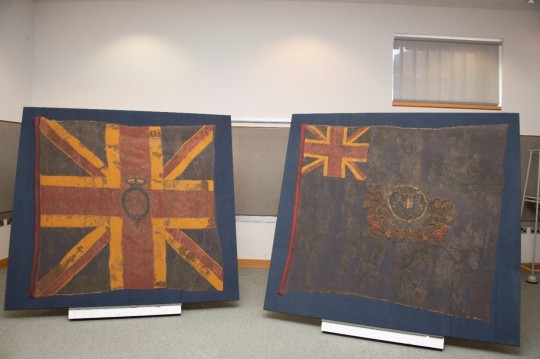
The colours had become fragile, fragmentary and soiled. Large areas of silk loss made the flags very hard to interpret. Surprisingly, the complex embroideries which decorated the centre of the flags were predominately intact although structurally very weak.
The conservation treatment of these two flags included: surface cleaning; removal of the central embroideries; wet cleaning; crease removal; mounting on a padded board covered by a digitally printed image of the flag to enable interpretation and covering with a specially dyed nylon net which prevents the loss of the fragmentary silk.
The conservation will enable access, display and research by ensuring the longevity of these precious and important flags.
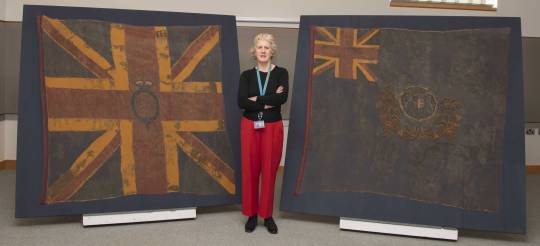
SOURCE
27 notes
·
View notes
Text
Kanhoji Angre: the 18th-Century Maratha Admiral, Pseudo-Pirate, and All-Around Badass
So this post got more notes than I expected it to, so I figure I may as well follow through on my promise to make a post about him! You want to know about the aforementioned badass 18th-century Maratha navy admiral and pseudo-pirate who repeatedly fended off Western invasion in India? Then you shall. I wrote a paper about this guy, so here we go.

Let me introduce you to Kanhoji Angre. Information is scant on his early life and career—sources tend to disagree about his true origins and we don’t know a lot about his family status, but modern historians tend to trace his lineage to Tukoji Angre, his father, who distinguished himself in the early Maratha navy. We know Kanhoji was descended from a long line of Maratha mariners, which meant he fought in a number of naval raids and became acquainted with naval tactics as he grew up. As an adult, he began hiring out his own fleet to the Maratha navy itself, which, at the time, consisted only of numerous small ships and sought Angre’s heavier armament, which would become essentially the centerpiece of the naval force. In a sense he single-handedly built the Maratha navy into quite a formidable force, becoming Sarkhel, or admiral in 1698, and establishing numerous insurmountable forts along the coast.
Of course, the turn of the 18th century also coincided with growing European colonial intentions in India, and Angre’s presence is well-documented in East India Company records as a nuisance, a pirate, and a warlord in different capacities. To the English, he was a formidable pirate, a scourge to European ships on the west coast of the Indian subcontinent, and a menace to the Company, who suffered significant losses at his hand. Their interactions would eventually escalate into full-on military altercations, and the Company would go as far as to seek allyship with the Portuguese and the Viceroy of Goa, but Angre would remain undefeated throughout his lifetime, which consisted of many other interactions with various Western powers. He was arguably the most powerful maritime figure on the Indian coast by the time he died, but the European primary sources tend to play that down as far as they can for obvious reasons.
But I know you’re wondering—was he, then, a pirate? Well, it depends on who you ask. While Kanhoji Angre did, in certain ways, engage in actions that could be considered piracy from an English perspective, he still operated by a clear code of conduct. One account from 1716 tells of an interaction during which Angre detained an East India Company ship to determine whether they had a pass from the governor of Bombay, with whom he was bound to a nonaggression agreement, but otherwise did them no harm when he discovered they did. On the other hand, that same account quickly makes sure to mention how Angre would pursue vessels from Madras and Calcutta, the governments of which he had no agreements with. In the words of Patricia Risso in her excellent article about the topic, Angre “did not share the English legal definition of maritime violence,” which led to the inevitable branding of him as a pirate by the British, despite the fact that he did operate legally in accordance with those with whom he had such legal agreements. Whether this makes him a pirate or not is ultimately a matter of perspective, but in my humble opinion it certainly does not make him less cool.
Regardless of his status as a pirate or a military leader, Kanhoji Angre is a fascinating, highly overlooked, and pretty damn awesome figure in maritime history, and it’s a shame we don’t have more information on him. If you’re interested in more of the primary source material, I’d recommend checking out Clement Downing’s A Compendious History of the Indian Wars: With an Account of the Rise, Progress, Strength, and Forces of Angria the Pyrate, published in 1737 (free on Google Books!), for one such English perspective, which is the source I based my initial paper on. This is mostly my excuse to infodump about a guy I think history Tumblr would love, and who stands to be appreciated more for being an interesting dude and an all-around badass.
#i wrote 10 pages on this guy last semester I can do it again#the captain's lectures#age of sail#piracy#golden age of piracy#indian military#maratha military#maratha#naval history#colonialism#east india company#maritime history#this is your captain speaking#long post
27 notes
·
View notes
Text

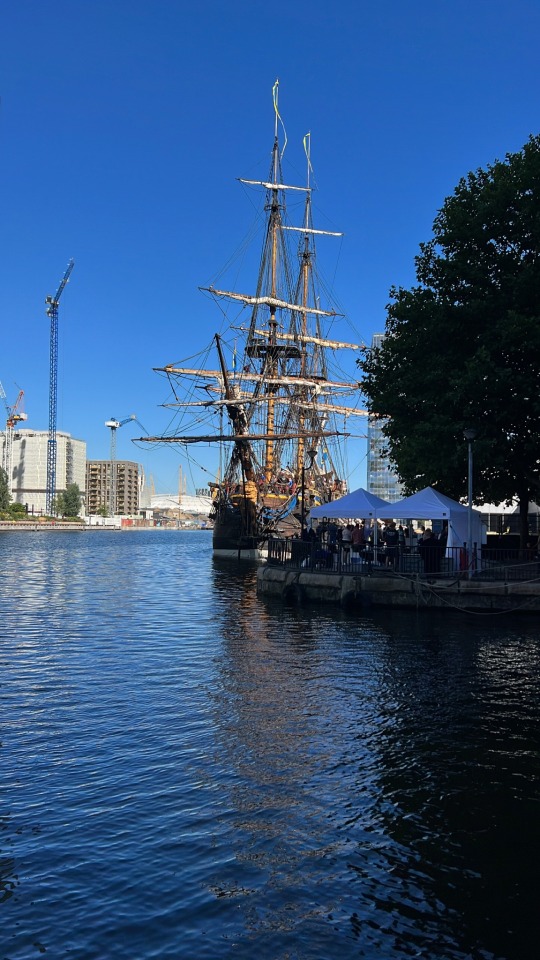


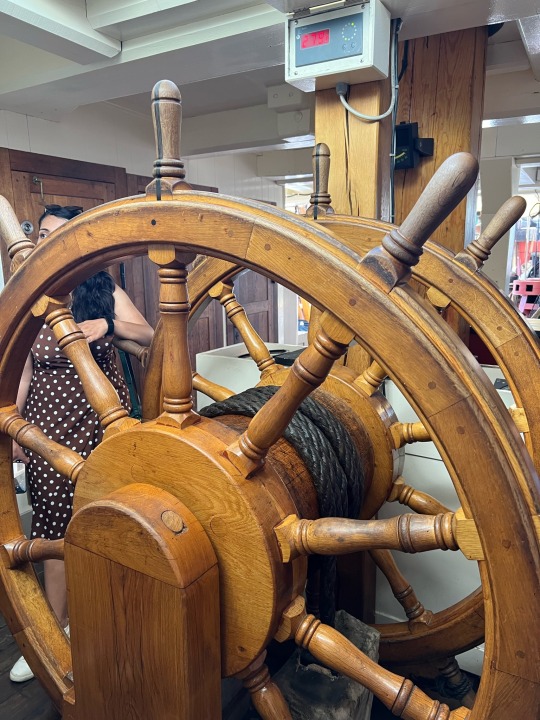



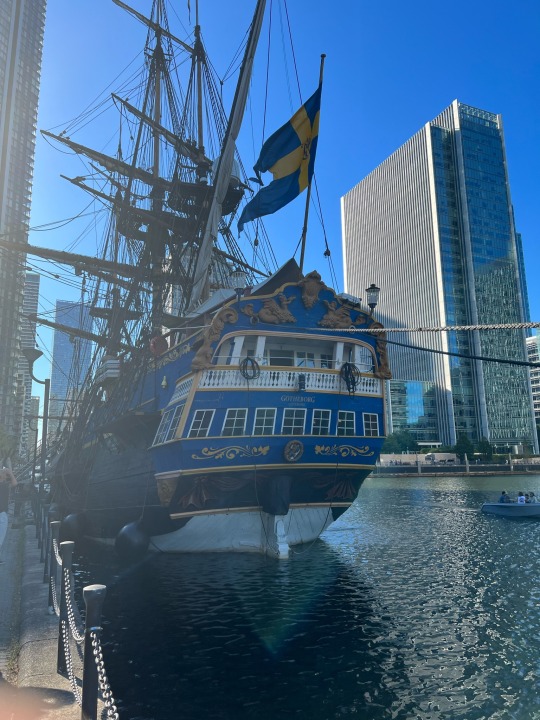

Went and visited Götheborg last week. A replica of an 18th-century Swedish East Indiaman, currently on a voyage to China.
#personal#sailing#sailing ship#east india company#East Indiaman#tall ship#sweden#swedish east india company
308 notes
·
View notes
Text
@baldy-wan-kenobi reading the Destroyermen series:

Quote from the man himself: "It's true, man. I'm being haunted by the ghost of English imperialism."
#destroyermen#destroyermen series#east india company#ruins everything forever#even on alternate Earths
7 notes
·
View notes
Text

Lord Cutler Beckett & Christmas Tree - by Bormoglot
#potc#potc fanart#pirates of the caribbean#cutler beckett#captain jack sparrow#on stranger tides#east india company
10 notes
·
View notes
Text
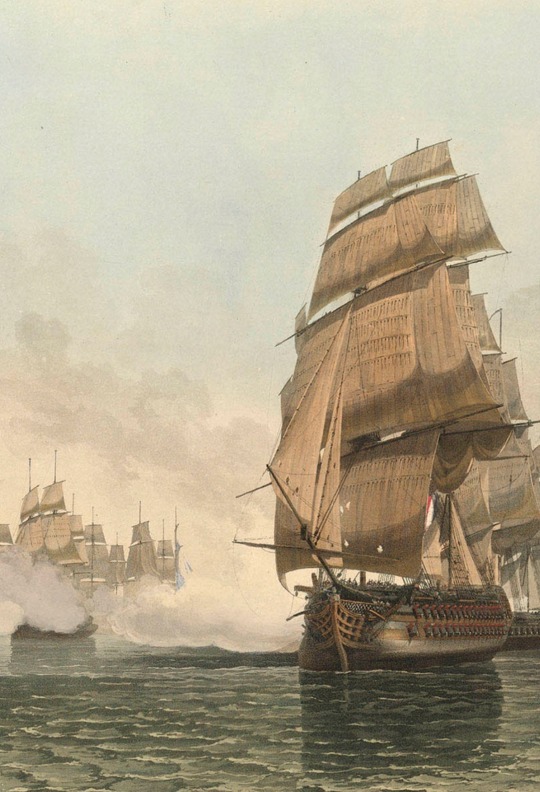
"Well done my lads!" cried Captain Oughton; "well done! that broadside was a staggerer—right into his ribs. Hurrah now, my hearts of oak! this fellow's worth fighting. Aim at his foremast—another broadside will floor it. It's on the reel—Newton, jump forward, and—"
But the order was stopped by a grape-shot, which struck Captain Oughton on the breast. He staggered and fell off from the poop to the quarter-deck. Newton leapt down, and went to him. The torrents of blood from his breast at once told the tale; and Newton called to some of the men, that his commander might be taken below.
"Wait a moment, my dear lad," said Captain Oughton, faintly, and catching his breath at every word; "it's a finisher—can't come to time—I die game."
— Frederick Marryat, Newton Forster
The homeward bound fleet of Indiamen from China under the command of Captain Dance engaging and repulsing a squadron of French men of war near the straits of Malacca Feb.y 15.th 1804 (detail), by William Daniell.
#frederick marryat#captain marryat#age of sail#newton forster#east india company#age of fighting sail#naval battle#british literature#william daniell#naval art#the event in the book is a fictional retelling of the battle in the print by william daniell
101 notes
·
View notes
Text

Götheborg of Sweden
444 notes
·
View notes
Text
An inaccurate telling of American History Part 1
#talkin#ace vane#american history#american revolution#boston tea party#samuel adams#ben franklin#east india company
77 notes
·
View notes
Text
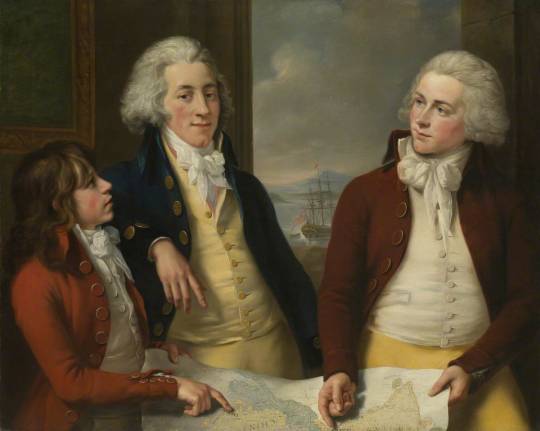
These guys are not only about to drop the hottest album of 1788, they are literally THE MONEY BROTHERS.
William Taylor (1769–1834), James (1772–1833), and Robert (1775–1803): the sons of William Money (1738–1796), a Director of the East India Company. William Taylor, at centre, wears the uniform of a lieutenant of the East India Company marine service, and his younger brother Robert points to Canton (Guangzhou) on a map of China. James, at right, points to Calcutta (Kolkata).
#the imperialism level is off the charts#the money brothers#east india company#1780s#1790s#georgian era#age of sail#imperialism#dressed to kill#fashion
50 notes
·
View notes
Text
Here is a really interesting read by Deb Chandra on how the Boston Tea Party was precipitated by The 1770 Bengali Famine
“Now, on its two hundred and fiftieth anniversary, it’s worth knowing the full story behind the Boston Tea Party. Like the patriots of 1773, our lives are affected by interactions between the global climate and the actions of imperial powers and corporate interests. The Boston Tea Party participants recognized the common ground they shared with people living on the far side of the planet. Their example inspires us to do the same.”
3 notes
·
View notes
Text
Imagine losing your rudder at sea and being rescued by of all things, a large East Indiaman! I imagine the crew were questioning whether they had slipped into a alt-history book without noticing it.

https://www.gotheborg.se/news/rescue-of-sailing-boat
8 notes
·
View notes
Text
The coming of Richard Canning and Diana Villiers had been a godsend to Bombay, bored as it was with the Gujerat famine and the endless talk of a Mahratta war. Canning had an important official position, he had great influence with the Company, and he lived in splendour; he was an active, stirring man, ready and eager to take up any challenge, and he made it clear that he expected their ménage to be accepted. Several of the highly-placed officials had known her father, and those with Indian concubines made no difficulty; nor did the bachelors; but the European wives were harder to persuade. Few had much room to cast stones, but hypocrisy has never failed the English middle class in any latitude, and they flung them in plenty with delighted, shocked abandon—rocks, boulders, limited in size only by fear for their husband's advancement. Conciliating discretion had never been among Mrs Villiers's qualities, and if subjects for malignant gossip had been wanting she would have provided them by the elephant-load.
Patrick O'Brian, HMS Surprise, 1973.
#HMS Surprise#Patrick O'Brian#aubrey maturin series#diana villiers#bombay#mumbai#india#east india company
2 notes
·
View notes
Text
💥💥💥
2 notes
·
View notes